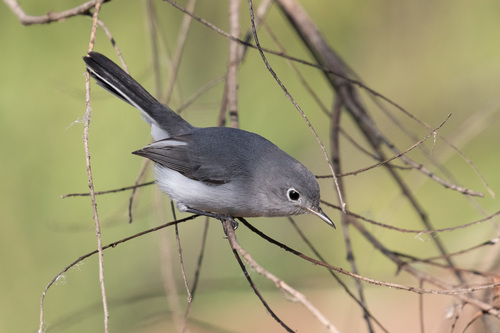
Blue-grey Gnatcatcher
The Blue-grey Gnatcatcher (Polioptila caerulea) is a tiny, active songbird known for its distinctive bluish-gray plumage and long, expressive tail, often cocked at an angle. It plays a crucial role in controlling insect populations within its range. While not globally threatened, it faces localized challenges due to habitat loss. It holds no particular cultural significance but is a favourite amongst birdwatchers for its energetic behavior.
10-13 cm
Length
16-18 cm
Wingspan
Least Concern
Conservation Status
Distribution
The Blue-grey Gnatcatcher has a wide distribution, ranging from the southern United States and Mexico to Central America. Migratory populations breed in the US and winter in the southern part of the range. They are found at a variety of altitudes, from sea level to around 2,500 meters.
Lifespan
Typically 3-4 years in the wild.
Blue-grey Gnatcatcher's Habitat
Habitat Types
Woodlands, Scrublands, Riparian thickets, Forest edges, Chaparral
Climate Zones
Temperate, Subtropical, Tropical
Adaptations
Their small size and agility allow them to maneuver through dense vegetation to glean insects. Their fine, pointed bills are well-suited for picking small prey from leaves and branches.
Variations
Several subspecies are recognized, differing slightly in plumage shade and size, primarily based on geographic location.
Appearance
Breeding Plumage
Males have a black line above the eye during breeding season, which is absent or less prominent in non-breeding plumage. Females generally lack this black line.
Seasonal Feather Changes
Plumage is generally brighter during the breeding season.
Sex Based Plumage Differences
Males are a brighter blue-gray, while females are a duller gray-blue.
Notable Features
Long, black tail with white outer feathers, Thin, pointed bill, White eye-ring
Diet and Feeding
Primary Foods
Insects, Spiders, Insect larvae, Small invertebrates
Foraging Behavior
Blue-grey Gnatcatchers actively glean insects and spiders from foliage, often hovering briefly to pick prey from leaves and branches. They may also catch insects in mid-air.
Specializations
Their fine, pointed bill is perfectly adapted for picking small insects and spiders from leaves and crevices.
Seasonal Diet Variations
Diet remains largely consistent year-round, focusing on available insects. During periods of insect scarcity, they may supplement their diet with small berries, but this is not a primary food source.
Behavior
Social Structure
Generally found in pairs or small family groups, especially during the breeding season. They may join mixed-species flocks outside of the breeding season.
Communication
A thin, buzzy 'spee' call, A scolding chatter, Tail flicking and wing movements
Migration
Many populations are migratory, moving south for the winter. The timing and distance of migration vary depending on the breeding location.
Territorial or Group Behaviors
Blue-grey Gnatcatchers are territorial during the breeding season, actively defending their nesting area from other gnatcatchers and potential predators.
Conservation
Threats
Habitat loss and fragmentation, Pesticide use, Collisions with buildings
Protection Programs
Habitat conservation and restoration efforts, Monitoring programs
Local National Laws
Protected under the Migratory Bird Treaty Act in the United States.
Population Trend
Stable
Population Estimates
The global population is estimated to be around 14 million.
Interesting Facts
They are known for their fearless behavior.
They will often approach humans and scold them, especially if they feel their nest is threatened.
They often incorporate spider silk into their nests.
This helps to bind the nest together and camouflage it.
They are highly active birds.
Constantly moving and foraging for insects.
Faqs about Blue-grey Gnatcatcher
What do Blue-grey Gnatcatchers eat?
They primarily eat insects, spiders, and insect larvae.
Where do Blue-grey Gnatcatchers live?
They live in a variety of wooded habitats, including forests, scrublands, and riparian areas.
Are Blue-grey Gnatcatchers endangered?
No, they are classified as Least Concern by the IUCN.
How can I attract Blue-grey Gnatcatchers to my yard?
Provide native trees and shrubs that attract insects. Avoid using pesticides.
Copyright @ Nature Style Limited. All Rights Reserved.
 English
English